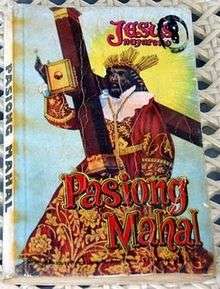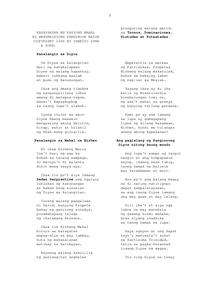Pasyon
 Cover of a typical edition of the Pasyóng Mahál, featuring a depiction of the Black Nazarene of Quiapo. | |
| Author |
Unknown; Gaspar Aquino de Belén (first written version) |
|---|---|
| Original title | Pasióng Mahal |
| Translator | filipino |
| Country | Philippines |
| Language | Tagalog, other Philippine languages |
| Genre | epic poetry, narration, religious, prayer |
Publication date | 1704 (de Belén Edition) |
| Media type | |
| Pages | ± 240 |
The Pasyón (Spanish: Pasión) is a Philippine epic narrative of the Passion, Death, and Resurrection of Jesus Christ. In stanzas of five lines of eight syllables each, the standard elements of epic poetry are interwoven with a colourful, dramatic theme.
The entirety of the text is chanted during the Lenten season and particularly during Holy Week. Its uninterrupted recitation is a popular Filipino Catholic devotion.
History
The text is an adaptation of the pre-Hispanic art of chanting epic poems as a form of oral tradition. After Christianity was introduced by the Spanish, the Passion cycle was adapted into the native art.
The indigenous form of the Pasyón was first written down by Gaspar Aquino de Belén in "Ang Mahal na Pasión ni Jesu Christong Panginoon Natin na Tola" ("The Sacred Passion of Jesus Christ Our Lord that is a Poem"), written in 1703 and approved in 1704.
An 1852 erudition by Aniceto de Merced, El libro de la vida ("The Book of the Life [of Jesus]") did not prove popular with the masses.
Pasyóng Genesís
The most popular Tagalog version of the Pasyón is the "Casaysayan nang Pasiong Mahal ni Jesucristong Panginoon Natin na Sucat Ipag-alab nang Puso nang Sinomang Babasa" ("The History of the Passion of Jesus Christ Our Lord that Surely Shall Ignite the Heart of Whosoever Readeth").
This version is also known as the Pasyóng Genesís as it includes the Genesis creation narrative preceding the portions on the lives of Mary and Christ, and as the Pasyóng Pilapil, after a foreword by a certain Dr Mariano Pilapil found in the 1814 printing. The book's title page describes it as being commissioned by former Archbishop of Manila José Seguí, O.S.A. and former Augustinian provincial Manuel Grijalvo, O.S.A., with corrections to the Latin phrases within by a certain Fr Amador W. Cruz.
A widely-circulated version of this is the 1949 edition published by Ignacio Luna and Sons, Co., whose title begins with Awit at Salaysay... ("Song and Narrative") instead of Casaysayan.
Devotional use

The Pasyón is normally heard during Holy Week in the Philippines, where its recitation is known as the Pabása ("Reading"). The rite can span several days, extending no later than Black Saturday, but often ended at noon or before 3 pm of Good Friday (the time when Jesus died on the cross).
Readers chant the Pasyón from beginning to end without pause; this non-stop recitation is facilitated by the chanters working in shifts. The chanters usually perform the rite as a panatà ("vow"), or votive offering in request or thanksgiving. They are frequently aged women, but in recent years some of the younger generation have shown increased interest in it.
The Pasyón is almost always chanted facing a temporary or permanent altar within the home, or inside a temporary outdoor booth, covered on the sides by cut palm leaves. This may also be performed at a local visita/kapilya (chapel of ease) or some other communal area.
As per Filipino etiquette, the host of the Pabasa (usually the master or mistress of the house it is held in) ensures a continuous supply of food and refreshments for the shifts of chanting devotees.
Musical setting
There are traditional tunes that the Pasyón is set to, and these have been passed down through the generations. Recent innovations include setting the epic to popular ballads, pop music, and contemporary hymns. Instrumental accompaniment to the Pabasa, while common, is by no means uniform in practise; the guitar and keyboard are popular instruments.
